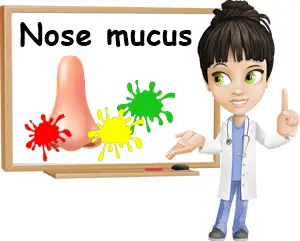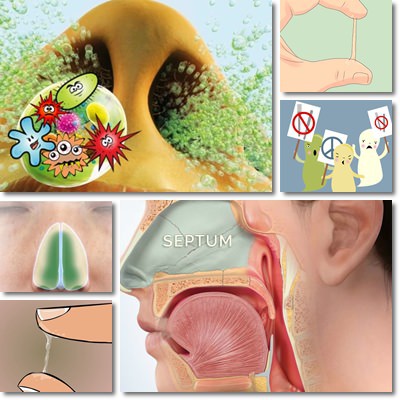Mucus is a viscous substance produced by mucous membranes in our body. It coats many areas of our body, particularly openings such as the mouth, throat or nose.
Mucous serves several important functions, notably moisture preservation and protection. Depending on the membranes it is secreted by, its color and texture may vary slightly.
Any change in our state of health will be reflected in the appearance of our mucus and each color has new meaning.
Nasal mucus in particular is highly susceptible to the changes in our state of health, mainly because the nasal mucosa is in direct contact with the outside world and thus more prone to infection and sickness in general.
As a result, colors such as yellow, green or brown can be seen quite often, while texture can vary from viscous to watery or thick. Knowing what different colors and textures mean can help us rapidly identify the health issue and choose the best treatment for us.

Different nasal mucus colors indicate different ailments and health issues. However, as personal experiences reveal, there is more to our health than just our nasal mucus color. Any additional sign or symptom, be it fever, rash, itch or breathing problems, represents valuable information that will contribute to identifying the cause behind the most peculiar nose mucus colors as well as guide us towards choosing the best treatment options. Find out below what are the most and least common nasal mucus colors and their meanings.
What causes different nose mucus colors?
Clear, sticky mucus
Transparent, somewhat sticky, but moist nasal mucus is normal, as long as our nose produces it in moderate amounts (just enough so we don’t feel our nose dry out, but not enough so we feel the need to blow our nose constantly or the mucus drips out of our nose).
The mucus produced by our nose lining will eventually drip down our throat and into our stomach unnoticed.
White, thick, sticky mucus
Thicker, more consistent nasal mucus of a non-translucent white color is generally a result of inflammation due to seasonal allergies. Sneezing, nose stuffiness, lightheadedness or drowsiness may be accompanying symptoms.
Dairy consumption may also make nasal mucus thicker and more difficult to expel, but does not directly contribute to its white color.
The extra time it would take our body to flush it out contributes to it losing moisture, becoming more compact and thus appearing whiter.

Thick, white nasal mucus may be normal in some people, but, for the most part, it indicates inflammation of some kind. While seasonal allergies are a common cause (they cause inflammation at the level of the nose lining), thicker than usual, white mucus can indicate the beginning of a respiratory infection as well. Symptoms such as fever, sinus congestion, nasal congestion etc. may be present.
Find out more about white mucus in the nose and throat.
Clear or whitish watery mucus
Whenever my seasonal allergies act up, I experience a runny nose and an increased production of clear-whitish, watery mucus that simply drips out of my nose.
Frothy mucus
Frothy mucus, more often expelled via mouth, can be caused by acid reflux problems. Symptoms such as heartburn, burning sensation in the stomach area or throat, coughing and acid rising into throat and mouth may appear.
At the same time, it may indicate lung disease such as pneumonia or edema.
Yellow mucus
Yellow nasal mucus can be thicker or more watery and usually indicates a respiratory infection. The darker the yellow color, the more advanced the infection. Nasal congestion, fever, sore throat and soreness in general, dry nose and other symptoms specific of a respiratory infection can appear. The yellow color indicates the presence of white blood cells fighting the infection as well as dead bacteria or viruses.
Green mucus
Green nasal mucus is generally indicative of a severe respiratory tract infection. Ironically, the green color is not produced by bacteria or viruses, but by a type of white blood cells called neutrophils, which contain a greenish enzyme. It is this enzyme that colors mucus green, the color itself being a sign of the extent of the infection and of the large number of white blood cells present at the site of the infection.
Brown nasal mucus
This can indicate the presence of blood, depending on the amount of red mucus expelled. Blood may come from the windpipe, voice box, lungs or even back of the nose. However, brown nasal mucus may also be a result of inhaled dirt or smoke. Brown phlegm (coughed mucus) is common in many smokers as well, but can be a result of our choice of foods (paprika, chocolate, coffee, cocoa).
Pink, red or clear mucus with reddish streaks
This most likely indicates the presence of blood. Clear mucus with pink or red streaks may be a result of tiny broken blood vessels in the nose lining or, rarely, bronchitis. Nasal mucus that is pink or red entirely and is not a result of a current nosebleed should be checked out by your doctor.
Grey mucus
Grey nasal mucus or clear nasal mucus with grey streaks may be caused by inhaling dust or smoke of some kind, resins or pollutants. These substances are then flushed out along with the mucus, resulting in lighter or darker grey streaks. I have noticed grey streaks every time I blow my nose after going out on a windy day. Sometimes I find tiny, black lines. After cleaning the dust around the house and finding the same grey or black streaks in my nose mucus I realized where they really came from and calmed down.
Black mucus
Black nasal mucus is quite serious. Long time smokers often notice black phlegm and nasal mucus after they quit smoking for a little while. It has been suggested that quitting smoking allows the lungs to somewhat clean themselves of tar, resins or other substances in cigarettes, as well as pollutants. Coal workers may experience black mucus as well, but the color can also indicate old blood from tuberculosis, bronchitis, emphysema or other more serious lung diseases.
Depending on the condition causing the black color, other more telling symptoms may be present.
For example, a productive cough or difficulty breathing are common in tuberculosis or obstructive lung disease. In any case, both black nasal mucus and black phlegm should be investigated by a medical professional as soon as possible.
Orange mucus
Orange nasal mucus as well as orange phlegm actually refer to a darker yellow or slightly orange mucus discharge.
While it is generally indicative of an infection, it may be due to remaining blood from broken blood vessels in the nose, for example.
Conclusion
Different mucus colors are indicative of different ailments. However, this is not always true as tests have shown that thick white, yellow and even green nasal mucus may be absolutely normal for some people. The trick is to look for other symptoms that could indicate infection, allergy or respiratory tract disease. Treatment should be pursued according to your doctor’s recommendation.
